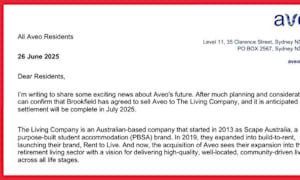We started introducing the use of life-sized plans in our development projects earlier this year.
Essentially, we have our draft architectural plans for several potential aged care centre developments projected to scale onto a warehouse floor by a business called Lifesize Plans, and fill the rooms outlined on the floor with actual beds, lounges, dining chairs and tables to experience how the space will feel and function when constructed.
We engage people to test the ease of movement in the space using walkers, wheelchairs and other mobility aids. This assists us to better understand whether there’s enough space to comfortably and safely manoeuvre around furniture, and if the travel distances between bedrooms and communal spaces are suitable.
Ultimately, it enables us to test and adjust our plans to optimise each residents’ interaction with, and enjoyment of, the space.
For us, this is a completely new way of testing the environments we design – and we’re finding this type of testing to be an invaluable phase in the process.
It’s helping us to ensure the spaces we create best meet our residents’ needs before we move into finalising our designs for construction. By reducing the need to make changes mid-project, we expect this to save time and costs as well as improve the overall resident experience.
So far this year, we’ve walked through life sized plans for four potential project designs.
Depending on which plan is being examined, the process can take anywhere from one and a half to three hours. The floor plans are projected to scale from an array of suspended projectors along the roof of a warehouse. We use an iPad to control which part of the plans we want to look at.
It takes a team of people representing several different parts of our business to examine the plans and test out their liveability. This includes representatives from the operating business, property development, strategy, innovation, as well as our architects.
We’re also experimenting with other methods of testing the environments we design with prototypes and virtual reality. We have built two care bedrooms that we’re using to determine everything from the best type of door handle, tile colours, what type of bathroom vanity, position of the TV, lighting levels and the line of sight from the bed head to the toilet. We examine it all through the lens of whether it will help or hinder our residents.
Soon, we’ll also be using virtual reality goggles in the early design stages as an additional way to get a true feel for the spaces we plan to develop.










